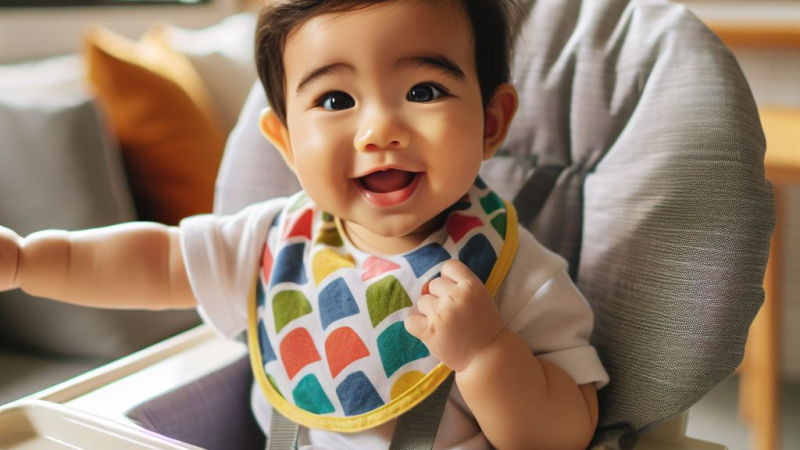
Complete Guide to Baby Bibs: Types, Materials, Benefits, and Updated Regulations
Everything you need to know to choose the best baby bib for your little one.
Why are Baby Bibs Important?
Baby bibs are an essential accessory in a baby's daily life, not only to protect their clothes from food but also to keep their skin clean and prevent irritation. Bibs have evolved significantly in recent years, offering different types, materials, and features that cater to the needs of the youngest members of the family.
Babies are at a stage where their digestive system is still adjusting, and food can easily spill, whether during breastfeeding or the introduction of solid foods. This is where bibs play a crucial role:
- Protect Clothes: Bibs prevent food, liquids, and saliva from staining the baby's clothes, which is particularly useful during the first solid food meals.
- Prevent Irritation: Constant contact with saliva and food can irritate a baby's delicate skin. Bibs help keep the skin dry and free from stains.
- Ease of Cleaning: Using a bib means that the baby's clothes stay cleaner during meals, reducing the need to change outfits multiple times a day.
Types of Baby Bibs
There are several types of bibs, each designed to fulfill a specific function. Here are the most common ones:
1. Cloth Bibs
Cloth bibs are a classic and very popular option. They are made from different types of fabric such as cotton, fleece, or even recyclable materials.
- Advantages: They are absorbent, comfortable, soft, and washable.
- Disadvantages: They are not waterproof and may take longer to dry.
2. Waterproof Bibs
Waterproof bibs are made from synthetic or plastic materials, providing greater protection against liquids.
- Advantages: They are resistant to water and easy to clean.
- Disadvantages: They may be less comfortable in warm climates and not as absorbent as cloth bibs.
3. Silicone Bibs
Silicone bibs are a modern and practical option for parents. They are made from food-grade silicone, which is completely safe for babies.
- Advantages: Easy to clean, durable, and waterproof.
- Disadvantages: They can be less comfortable due to their stiffness.
4. Gauze Bibs
Gauze bibs are made from a light and breathable fabric, typically composed of cotton or a blend of natural materials.
- Advantages: Comfortable and absorbent for saliva.
- Disadvantages: They do not provide complete protection against liquids and may stain more easily.
5. Bibs with Pocket Catchers
This type of bib has a pocket at the bottom that catches food crumbs during mealtime, preventing them from dirtying the baby's clothes or the floor.
- Advantages: Very practical, especially for babies starting solid foods.
- Disadvantages: They tend to be larger and may be a little heavier.
Baby Bib Safety and Regulations
It is important that bibs comply with safety regulations to ensure that they do not pose any health risks to babies. Below are the main regulations governing these products:
1. European Regulation (CE) for Children's Products
In Europe, children's products, including bibs, must comply with the EN 71 standard, which regulates the safety of toys. This regulation ensures that materials used are not harmful to the baby's health.
2. Food Safety Regulations (FDA)
For products made from silicone, it is essential that they are food-grade, meaning they are free from harmful substances such as BPA, PVC, and other chemicals.
3. Material Certifications
Bibs should be made from hypoallergenic materials, free from harmful chemicals such as phthalates, lead, and formaldehyde, ensuring they are safe for the baby's sensitive skin.
4. Durability Testing
Bibs should be tested for durability, resistance to stains, and ease of washing to ensure they remain effective over time.
Tips for Choosing the Right Baby Bib
- Baby's Age: Choose a bib that is suitable for your baby's age.
- Comfort: The bib should be soft and comfortable for the baby.
- Ease of Cleaning: Choose a bib that is easy to clean, especially if your baby is starting to eat solids.
- Safety: Ensure the bib is made with non-toxic materials and meets all safety standards.
FAQ About Baby Bibs
How often should I change my baby's bib?
It is recommended to change the bib after every meal or when it gets wet or dirty. This helps prevent bacteria buildup and keeps your baby's skin dry.
Can I use the same bib all day?
It is not recommended. It is best to have several bibs on hand since babies tend to get dirty frequently. Having multiple bibs makes it easier to rotate and clean them.
Are silicone bibs safe?
Yes, as long as they are made from food-grade silicone and certified by the appropriate authorities. Make sure the bib is free from BPA, PVC, and other harmful substances.

